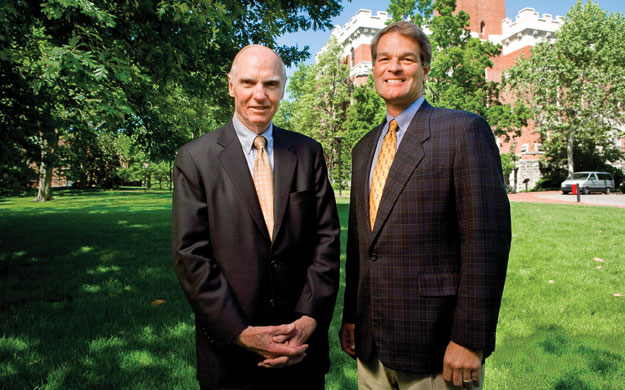
Rodes Hart and Orrin Ingram believe in Vanderbilt. As alumni, trustees, philanthropists and visionaries, they reflect on the opportunities—and challenges—of eliminating need-based loans and increasing scholarship endowment.
Rodes Hart, who graduated from the College of Arts and Science in 1954 and now serves as chair of Vanderbilt’s $1.75 billion Shape the Future campaign, joined the Vanderbilt Board of Trust in 1979, becoming trustee emeritus in 2007.
Orrin Ingram received his bachelor’s degree from Vanderbilt in 1982. A member of the Board of Trust since 2002, he chairs its Medical Center Affairs Committee and serves as vice chair of the Shape the Future campaign. He also chairs the Vanderbilt-Ingram Cancer Center Board of Overseers and the Vanderbilt University Medical Center Board.
These two leaders answered questions about Vanderbilt’s commitment to replace need-based undergraduate loans with scholarships and grants—and the $100 million philanthropic effort, Opportunity Vanderbilt, that will sustain this historic expansion of financial aid.
Why is Vanderbilt’s expanded financial aid initiative, with its emphasis on scholarships rather than loans, so important?
Hart: It’s the right thing to do. Scholarships replace the burden of student loans, and those loan obligations can adversely impact students’ career choices or their plans for advanced or professional education. We want to ensure that financial need is not a deterrent for highly qualified students who want to attend Vanderbilt.
Ingram: When a class is made up of individuals of all economic, geographic and cultural backgrounds and experiences, that blend enriches the learning environment for the whole class—and every student.
Opportunity Vanderbilt is seeking $100 million in new gifts to support this financial aid initiative. Why not postpone this, given the current economy?
Ingram: By waiting we could be denying someone who is qualified a chance to attend our university. Though we are certainly mindful of the current economic climate, Vanderbilt’s strategic decisions and philanthropic priorities focus on what’s important to sustain the university’s mission over the long term. And increasing Vanderbilt’s scholarship endowment is crucial to that mission.
What has been Peabody’s progress toward the Opportunity Vanderbilt goal?
Hart: Peabody has set a goal of $6.5 million for new gifts to scholarship endowment for its undergraduates. To date, $3.04 million in gifts and pledges has been made by alumni, parents and friends.
Why not incur student loans in order to receive an education of the caliber Vanderbilt offers?
Hart: The young people Vanderbilt educates will be the leaders who will guide our country and positively influence societies throughout the world. But debt will influence their choices.
Vanderbilt has been addressing the challenge of student debt for many years, and since 2000, students’ loan burdens have been reduced by 17 percent. Scholarship giving to our Shape the Future campaign has had a vital role in those debt-reduction efforts, and Vanderbilt’s expanded financial aid announcement builds directly on the university’s long-term focus on this issue of student debt.
Approximately 54 percent of Peabody’s students receive some sort of financial aid. And it’s important to keep in mind that even as we eliminate loans in our financial aid packages, all families still have an expected financial contribution, and some families will meet that contribution through loans—so this expanded financial aid initiative does not make Vanderbilt cost-free.
How do you think the educational needs of your children and grandchildren are/will be different from those of your generation?
Ingram: Thank goodness I’m not in college right now. When I was in school, I was being prepared to compete with other companies inside the United States. My children are going to have to compete with businesses both within the U.S. and globally.
Hart: When I was in school, we used a slide rule. The tools of today are completely different. To maximize education today and tomorrow, students need a broad educational experience to cope with the fast pace of change and expansion of knowledge.
What makes Vanderbilt an important institution in today’s world?
Hart: There’s no doubt that Vanderbilt is equipping its students for leadership roles in an increasingly complex world—and Vanderbilt does that very well.
Ingram: Vanderbilt recognizes that big, important, game-changing breakthroughs and discoveries typically come at the interdisciplinary crossroads. At Peabody you will find neuroscientists partnering with educators to understand how students learn. Special education researchers combine forces with pediatricians and social psychologists to further discoveries that may help those with developmental disabilities. Students may pursue interdisciplinary majors across departments at Peabody or across departments between Peabody and the Blair School of Music, the College of Arts and Science or the School of Engineering. With this interdisciplinary approach, we’re finding ways to make the world a better place by having such bright students learn and collaborate with a great faculty, across all the arts and sciences.
Some might wonder if Vanderbilt and Peabody really need their support or whether a small gift can make any kind of difference at a big university with a sizable endowment. What do you tell alumni and others when you encounter that?
Ingram: You’d be surprised at what a difference a little can make in somebody’s life. A lot of “littles” can add up to be a lot. Our endowment per student isn’t as large as many other schools’—so every penny counts. Vanderbilt receives more than 85,000 gifts each year from alumni, parents and friends who give in amounts from $10 to $10,000.
Hart: Every gift is important and every gift makes a difference. Of course we need large contributions to reach the Opportunity Vanderbilt goal of $100 million and our overall Shape the Future goal of $1.75 billion—but we need gifts at every level. It will take success at all levels of giving to reach the goal—and I think you would agree with me that this program can reduce concern about affordability, especially for our education students, and make it possible for those who seek to impact others as teachers to receive a great education.